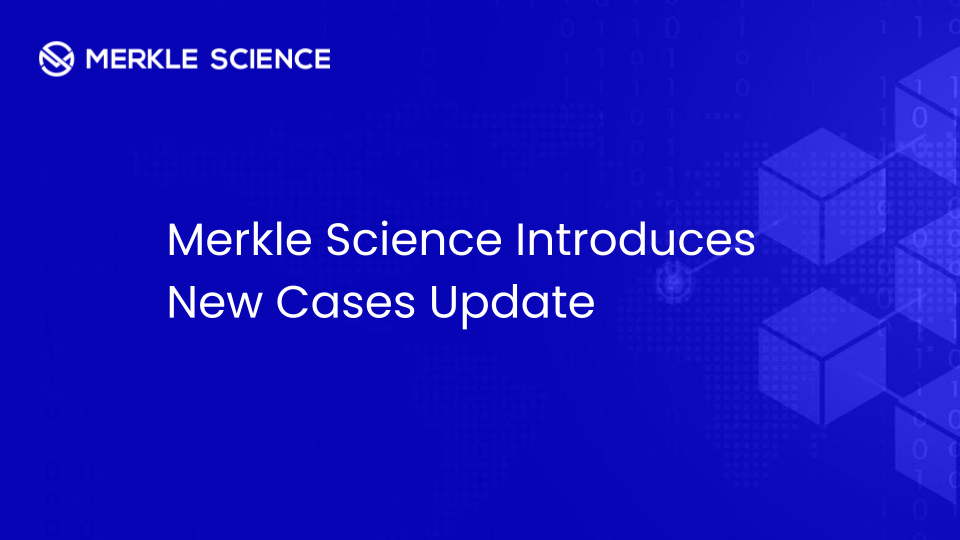Merkle Science Launches New Cases Update Increasing Efficiency in the Case Management Process

Merkle Science

Today, Merkle Science introduces the ‘Cases’ update — a capability enhancement to its Blockchain Monitoring Tool with the aim to make the case management process for compliance teams more accurate and efficient than ever before.
Over time, criminals have become more sophisticated in their approach and have concocted novel techniques to hide their identities and conduct illicit activities. More often than not, multiple entities, addresses, and transactions are involved in conducting suspicious activities. Recognizing this, in 2019 Hong Kong Securities and Exchange Commission (SFC) published a position paper calling for increased blockchain monitoring. The SFC urged crypto businesses to “employ technology solutions which enable the tracking of virtual assets through multiple transactions.” The new Cases update increases the effectiveness of the investigation process by providing compliance officers with clearer visibility of risks attached to interconnected cases. Compliance officers now have better visibility on suspicious activities connected to multiple associated addresses, transactions, and customers within a case through alerts on the platform’s holistic case details view. Further, our customers can prioritize their investigation team’s work based on the risk metrics attached to the case and plan for the investigation by distributing tasks across the team.
USERS CAN NOW ATTACH MULTIPLE ENTITIES TO A SINGLE CASE
Previously, Merkle Science users were able to analyze cases at an entity level — either at a transaction, address, or customer level.
However, often in real-world cases, compliance officers require a more holistic, aggregated view for investigations purposes. They need to be able to review multiple related entities such as transactions, addresses, and customers in a single case. Merkle Science’s ‘Cases’ update does exactly this, allowing compliance officers to attach multiple entities — from different types of tokens to multiple users and wallets — to a single case.
Fig. 1 - Case Creation Workflow: adding multiple entities to a single transaction
USERS CAN NOW CREATE A COLLABORATION-CENTRIC WORKFLOW
The new update also enhances our current case management feature by enabling our customers to create a collaboration-centric workflow. Compliance officers can link multiple, associated cases together, providing them with clear visibility of how different entities may be connected. Should any entities be linked to previous investigations, this will be immediately visible to compliance officers.
The case agents that are assigned to different cases can make associations and connections between their cases and share important insights, leading to improved results.
The new collaboration feature also lets users add comments as they investigate and monitor entities in a case over a period of time. This feature promotes efficiency in the investigation process by enabling users to track changes, add comments, and create alerts for all the entities that are associated with a case. Further, the customers can also create notes with attached documents for future reference.
Fig 2. - Adding comments to the existing cases to allow for greater collaboration
CASE ASSIGNMENT AND APPROVAL
The feature brings in case assignment logic which enables automatic distribution of cases created automatically. Previously, the users had to manually assign the case to the case managers, which may be inconvenient when compliance teams are handling multiple cases at the same time.
With the update, case managers can now use Merkle Science’s case management logic to ensure that the cases are evenly distributed throughout the team. There are two ways through which cases may be automatically assigned. First is the round-robin option wherein the cases are assigned, one by one, sequentially in a rolling fashion to a pool of agents. The second option is the ‘least outstanding case assignment’ option, whereby the case is assigned automatically to the case manager with the lowest number of non-closed/open cases. Lastly, customers can still assign cases manually to case managers based on their skills and expertise.
To ensure that no mistake is made during the transaction monitoring process, Merkle Science employs a maker-checker workflow for case approval. The principle of maker-checker ensures there must at least be two entities involved in closing a case. Merkle Science’s platform has put an approval mechanism in place, which allows users to select an approver based on their level of expertise. Only the selected approver has the permission to mark the cases as ‘closed’.
Fig. 3 - The assigning agent chooses the ‘least outstanding option’ to automatically assign cases. They then choose the mandatory approval option to ensure that the case is ‘closed’ only when an appointed case approver permits.
The ‘Cases’ update is available to everyone using the Merkle Science Blockchain Monitor Platform.
This update improves the user experience without changing the platform significantly. Merkle Science has added the ‘Cases’ tab at the top in the workflow management tool enabling the customers to create and modify cases.
Fig. 4 - Where to locate the Cases tab in the Workflow Management Tool


